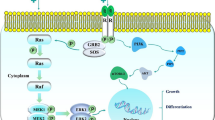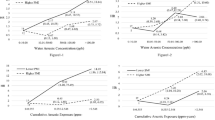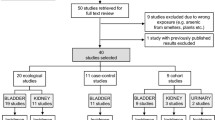Abstract
Although exposure to high levels of arsenic is associated with excess bladder cancer risk, lower exposures generally are not. This study represents the first biomonitoring of arsenic exposure in Tunisia and focuses on a possible association with bladder cancer risk. In this context, 124 male bladder cancer cases and 220 controls were recruited and blood samples were analyzed to determine the concentration of As. The study subjects were stratified into median groups based on concentrations of arsenic in their blood. Blood arsenic (B-As) was significantly two to threefold higher in bladder cancer cases than in controls (p < 0.05). The arsenic concentrations were significantly higher among both smokers and workers in construction. However, neither drinking water nor seafood was found to be incriminated as exposure sources. The adjusted risk ratios for B-As concentration categories 0.1–0.67 and ≥0.67 μg/L were 0.18 (95% CI = 0.014–2.95) and 2.44 (95% CI = 1.11–5.35), respectively. Arsenic levels were not found to be associated with tumor grade or stage. The considerable risk in the category of highest cumulative exposure argues for an association between bladder cancer risk and low-level arsenic exposure. Future investigations with larger samples and using techniques that allow the distinction of the different arsenic species should better elucidate this association. Furthermore, the modulation of arsenic level according to the histological grade may be of potential to be used as a diagnostic marker of the disease process and its possible relationship etiologically.
Similar content being viewed by others
References
Arain MB, Kazi TG, Baig JA, Jamali MK, Afridi HI, Jalbani N, Sarfraz RA, Shah AQ, Kandhro GA (2009) Respiratory effects in people exposed to arsenic via the drinking water and tobacco smoking in southern part of Pakistan. Sci Total Environ 407(21):5524–5530
Bates MN, Rey OA, Biggs ML, Hopenhayn C, Moore LE, Kalman D, Steinmaus C, Smith AH (2004) Case–control study of bladder cancer and exposure to arsenic in Argentina. Am J Epidemiol 159(4):381–389
Cancer Registry in Southern Tunisia (2002) Cancer incidence for the years 1997–1999. Available online on http://www.insp.nat.tn/fr/unite_the/regis/inci97.99b.pdf. Accessed July 2012
Chen CJ, Chen CW, Wu MM, Kuo TL (1992) Cancer potential in liver, lung, bladder and kidney due to ingested inorganic arsenic in drinking water. Br J Cancer 66(5):888–892
Chen CH, Chiou HY, Hsueh YM, Chen CJ, Yu HJ, Pu YS (2009) Clinicopathological characteristics and survival outcome of arsenic related bladder cancer in Taiwan. J Urol 181(2):547–552, discussion 553
Dictor MC, Baranger P, Chéry L, Michel K, Barbier J, Clozel B et al. (2004) Synthesis of research and development work in France (1999–2003) on the theme of arsenic. Final report. BRGM/RP53252–FR (2004) 130 pp; 4III; 3 Ann (in French)
De Vizcaya-Ruiz A, Barbier O, Ruiz-Ramos R (2009) Biomarkers of oxidative stress and damage in human populations exposed to arsenic. Mutat Res 674:85–92
Eblin KE, Bredfeldt TG, Gandolfi AJ (2008) Immortalized human urothelial cells as a model of arsenic-induced bladder cancer. Toxicology 248(2–3):67–76
El Kihel B (1995) Impact of discharges of phosphogypsum in the Gulf of Gabes: geochemistry of heavy metals in sediments. PhD dissertation, University of Tunis II, p 86
Gil F, Capitán-Vallvey LF, De Santiago E, Ballesta J, Pla A, Hernández AF, Gutiérrez-Bedmar M, Fernández-Crehuet J, Gómez J, López-Guarnido O, Rodrigo L, Villanueva E (2006) Heavy metal concentrations in the general population of Andalusia, South of Spain: a comparison with the population within the area of influence of Aznalcóllar mine spill (SW Spain). Sci Total Environ 372(1):49–57
Gil F, Pla A (2001) Biomarkers as biological indicators of xenobiotic exposure (review article). J Appl Toxicol 21:245–255
Hall M, Chen Y, Ahsan H, Slavkovich V, van Geen A, Parvez F et al (2006) Blood arsenic as a biomarker of arsenic exposure: results from a prospective study. Toxicology 225:225–233
Hamza- Chaffai A (1993) Study of metal bioaccumulation and metallothionein in fish from the coast of Sfax (Gulf of Gabes). PhD dissertation. University of Sfax, p 157
Huang SY, Chang CS, Tang JL, Tien HF, Kuo TL, Huang SF, Yao YT, Chou WC, Chung CY, Wang CH, Shen MC, Chen YC (1998) Acute and chronic arsenic poisoning associated with treatment of acute promyelocytic leukaemia. Br J Haematol 103:1092–1095
Illou S, Serbaji MM, Montacer M, Medhioub K (1996) Study of surface sediments of the northern coast of the city of Sfax—trace metals pollution. National Colloquium of Earth Sciences, Boumerdes
Illou S (1999) Impact of domestic and industrial telluric discharges on coastal environments: case of the northern coast of Sfax City (Tunisia). PhD dissertation, Sfax University
INVS (Institut National de Veille Sanitaire) (2002) Chronic exposure to arsenic water and health risks. Review of epidemiological data. Quantitative assessment of health risks in Auvergne Report, p 103. http://www.invs.sante.fr/publications/2003/arsenic/index.html. Accessed July 2012
Johnson AM, O'Connell MJ, Miyamoto H, Huang J, Yao JL, Messing EM, Reeder JE (2008) Androgenic dependence of exophytic tumor growth in a transgenic mouse model of bladder cancer: a role for thrombospondin-1. BMC Urol 8:7
Kurttio P, Pukkala E, Kahelin H, Auvinen A, Pekkanen J (1999) Arsenic concentrations in well water and risk of bladder and kidney cancer in Finland. Environ Health Perspect 107(9):705–710
Mandal BK, Ogra Y, Suzuki KT (2001) Identification of dimethylarsinous and monomethylarsonous acids in human urine of the arsenic affected areas in West Bengal, India. Chem Res Toxicol 14:371–378
Mandal BK, Ogra Y, Anzai K, Suzuki KT (2004) Speciation of arsenic in biological samples. Toxicol Appl Pharmacol 198(3):307–318
Mandal BK, Suzuki KT, Anzai K (2007) Impact of arsenic in foodstuffs on the people living in the arsenic-affected areas of West Bengal, India. J Environ Sci Health A Tox Hazard Subst Environ Eng 42(12):1741–1752
Marchiset-Ferlay N, Savanovitch C, Sauvant-Rochat MP (2012) What is the best biomarker to assess arsenic exposure via drinking water? Environ Int 39(1):150–171
Mink PJ, Alexander DD, Barraj LM, Kelsh MA, Tsuji JS (2008) Low-level arsenic exposure in drinking water and bladder cancer: a review and meta-analysis. Regul Toxicol Pharmacol 52(3):299–310
Morton WE, Dunnette DA (1994) Health effects of environmental arsenic. In: Nriagu JO (ed) Arsenic in the Environment, part II. Human Health and Ecosystem Effects. John Wiley & Sons, Inc., New York, pp 17–34
NRC (1999) Arsenic in drinking water. National Academy Press, Washington, pp 310
Olmedo P, Pla A, Hernández AF, López-Guarnido O, Rodrigo L, Gil F (2010) Validation of a method to quantify chromium, cadmium, manganese, nickel and lead in human whole blood, urine, saliva and hair samples by electrothermal atomic absorption spectrometry. Anal Chim Acta 5,659(1-2):60–67
Parkin DM, Chen VW, Ferlay J, Galceran J, Storm HH, Whelan SL (1994) Comparability and quality control in cancer registration. IARC Technical Report No. 19, IARC, Lyon
Parkin DM, Bray F, Ferlay J, Pisani P (2005) Global cancer statistics, (2002). CA Cancer J Clin 55:74–108
Pirkle JL, Osterloh J, Needham LL, Sampson EJ (2005) National exposure measurements for decisions to protect public health from environmental exposures. Int J Hyg Environ Health 208(1-2):1–5
Pomroy C, Charbonneau SM, Mccullough RS, Tam GK (1980) Human retention studies with 74As. Toxicol Appl Pharmacol 53:550–556
Rahman MM, Ng JC, Naidu R (2009) Chronic exposure of arsenic via drinking water and its adverse health impacts on humans. Environ Geochem Health 31(suppl 1):189–200
Roychowdhury T, Uchino T, Tokunaga H, Ando M (2002) Survey of arsenic in food composites from an arsenic-affected area of West Bengal. Food Chem Toxicol 40:1611–1621
Seifert B, Becker K, Helm D, Krause C, Schulz C, Seiwert M (2000) The German Environmental Survey 1990/1992 (GerES II): reference concentrations of selected environmental pollutants in blood, urine, hair, house dust, drinking water and indoor air. J Expo Anal Environ Epidemiol 10(6 Pt 1):552–565
Shiomi K (1994) Arsenic in marine organisms: chemical forms and toxicological aspects. In: Nriagu JO (ed) Arsenic in the environment, part II. Human health and ecosystem effects. Wiley, New York, pp 261–282
Smith AH, Hopenhayn-Rich C, Bates MN, Goeden HM, Hertz-Picciotto I, Duggan HM, Wood R, Kosnett MJ, Smith MT (1992) Cancer risks from arsenic in drinking water. Environ Health Perspect 97:259–267
States JC, Srivastava S, Chen Y, Barchowski A (2009) Arsenic and cardiovascular disease. Toxicol Sci 107(2):312–323
Steinmaus C, Moore L, Hopenhayn-Rich C, Biggs ML, Smith AH (2000) Arsenic in drinking water and bladder cancer. Cancer Invest 18(2):174–182
Steinmaus C, Yuan Y, Bates MN, Smith AH (2003) Case–control study of bladder cancer and drinking water arsenic in the western United States. Am J Epidemiol 158(12):1193–1201
Steinmaus C, Yuan Y, Liaw J, Smith AH (2009) Low-level population exposure to inorganic arsenic in the United States and diabetes mellitus: a reanalysis. Epidemiology 20(6):807–815
USEPA (2002) Arsenic in drinking water. US Environmental Protection Agency, Washington
Wadhwa SK, Kazi TG, Kolachi NF, Afridi HI, Khan S, Chandio AA, Shah AQ, Kandhro GA, Nasreen S (2011) Case–control study of male cancer patients exposed to arsenic-contaminated drinking water and tobacco smoke with relation to non-exposed cancer patients. Hum Exp Toxicol 30(12):2013–2022
Wanibuchi H, Salim EI, Kinoshita A, Shen J, Wei M, Morimura K, Yoshida K, Kuroda K, Endo G, Fukushima S (2004) Understanding arsenic carcinogenicity by the use of animal models. Toxicol Appl Pharmacol 198(3):366–376
WHO (2000) Guidelines for drinking water quality, volume 3. http://www.who.int/water_sanitation_health/dwq/dwqtraining/en/index.html. Accessed July 2012
Acknowledgments
We address our acknowledgements to the medical staff in Sfax Hospital who facilitated our sampling procedures and data collection on the subjects of the study. Our thanks are also addressed to Isabel Morino and José Santiago in the Department of Toxicology and Legal Medicine, Faculty of Medicine of Granada, for their considerable assistance in the analysis of metals. We would like finally to thank Dr Najla Kharrat for his help in the statistical analysis.
Disclosure statement
The study received ethics approval. Funding was provided by the Ministry of High Education and Scientific Research in Tunisia. The funders had no role in the study design, data collection and analysis, decision to publish, or preparation of the manuscript.
Conflicts of interest
The authors have no conflicts to report.
Author information
Authors and Affiliations
Corresponding author
Additional information
Responsible editor: Philippe Garrigues
Rights and permissions
About this article
Cite this article
Feki-Tounsi, M., Olmedo, P., Gil, F. et al. Low-level arsenic exposure is associated with bladder cancer risk and cigarette smoking: a case–control study among men in Tunisia. Environ Sci Pollut Res 20, 3923–3931 (2013). https://doi.org/10.1007/s11356-012-1335-9
Received:
Accepted:
Published:
Issue Date:
DOI: https://doi.org/10.1007/s11356-012-1335-9




